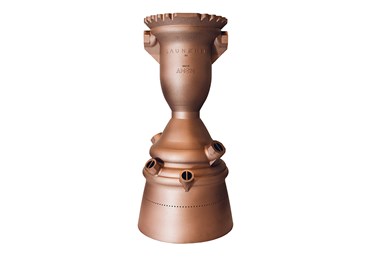AMCM Systems Open Possibilities for Demanding Metal Applications
The AMCM M 290 1 kW system is said to ensure that the finest structures, such as complex cooling channels, can be produced even in larger copper components.

The AMCM M 290 1 kW system can print 1 m high rocket engine combustion chambers (copper alloy).
Additive Manufacturing Customized Machines (AMCM), an EOS company, is customizing additive manufacturing (AM) systems to enable new applications in 3D metal printing not supported by standard AM systems. The customized AM solutions are based on proven EOS technology and processes, and built with varying degrees of customization, either almost completely new designs or as modified and enhanced EOS systems.
The AMCM M 290 1KW is an adaptation of the EOS M 290 with an increased laser power of 1kW. This opens further possibilities for demanding copper applications, among others. For applications such as inductors, heat exchangers or stators in the field of e-mobility, the combination of a large build area and a fine 80 µm spot enables the AMCM M 290 1 kW to ensure that the finest structures, such as complex cooling channels, can be produced even in larger copper components.
In these pure copper applications, the AMCM M 290 1 KW, in conjunction with the right process parameters, is said to achieve a 100% International Annealed Copper Standard (IACS) electrical conductivity to produce highly efficient components. By using the infrared fiber laser technology, customers are able to use all standard EOS processes in addition to those developed for the 1kW system. The system can also be equipped with two 1 kW lasers to further increase system throughput.
The EOS M 290 has been adapted with the smallest possible spot size and maximum component size to enable fine detail applications. With the AMCM M 290 upgrade, wall structures of 100 µm can be produced. The combination of finest spot sizes and the possible part size of 135 × 220 mm enables the sophisticated design of anti-scatter grids to be manufactured in a novel and optimized way, the company says. With a special software optimized for refractive tungsten, grids of reproducible high quality can be built without issue.
Related Content
-
Velo3D Qualifies Aluminum Alloy to Support Formula 1 Customers
Aluminum alloy supports Formula 1 customers by enabling the production of parts requiring high thermal conductivity and durability, and is available to print in both 50 and 100 micron layers.
-
Semiconductors, Tungsten, AM Affordability and More from Formnext 2024: AM Radio #56
The trade show included increased applications for the semiconductor market, machine launches and technology advances aimed at cost cutting, plenty of LFAM and more. Listen to our conversation on Formnext 2024.
-
With Electrochemical Additive Manufacturing (ECAM), Cooling Technology Is Advancing by Degrees
San Diego-based Fabric8Labs is applying electroplating chemistries and DLP-style machines to 3D print cold plates for the semiconductor industry in pure copper. These complex geometries combined with the rise of liquid cooling systems promise significant improvements for thermal management.










